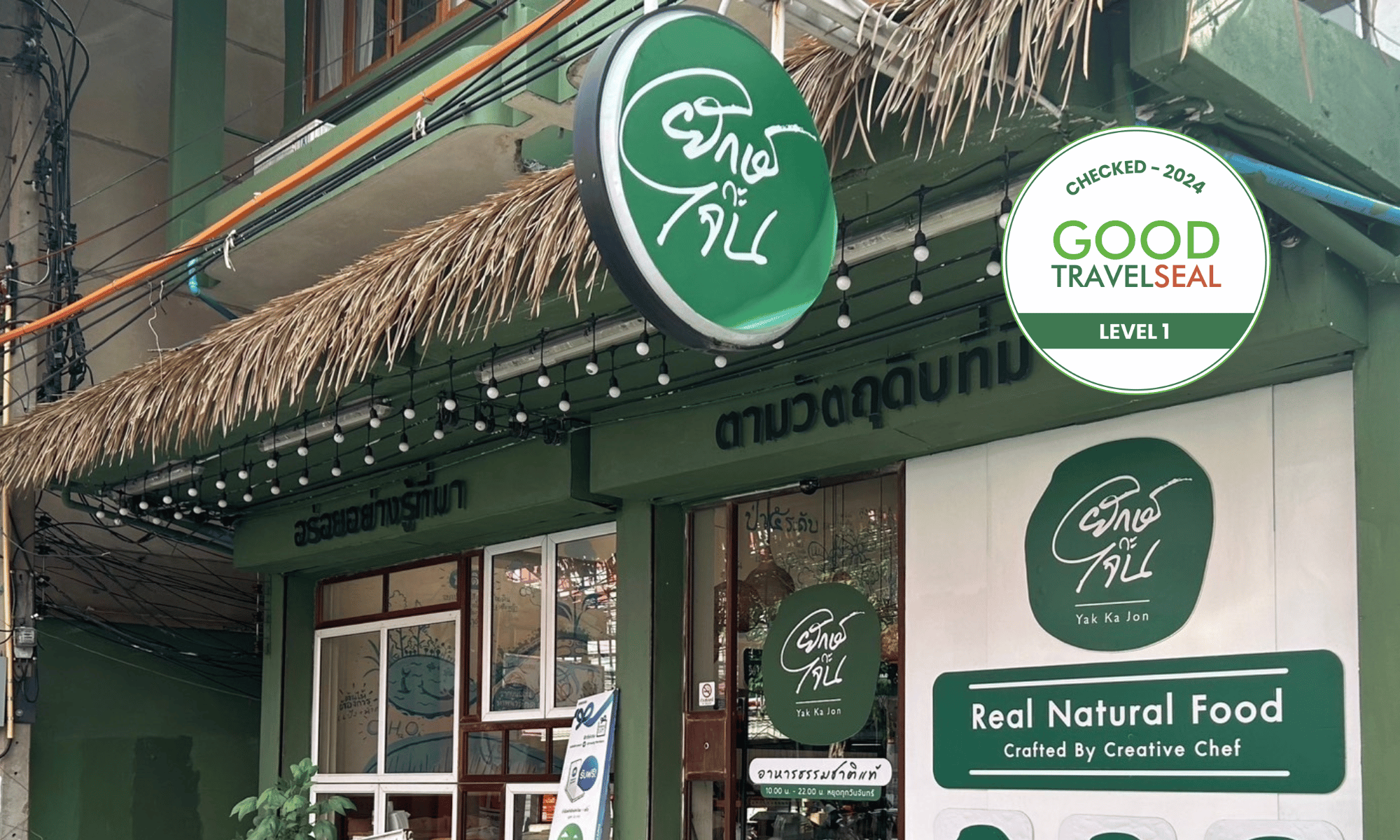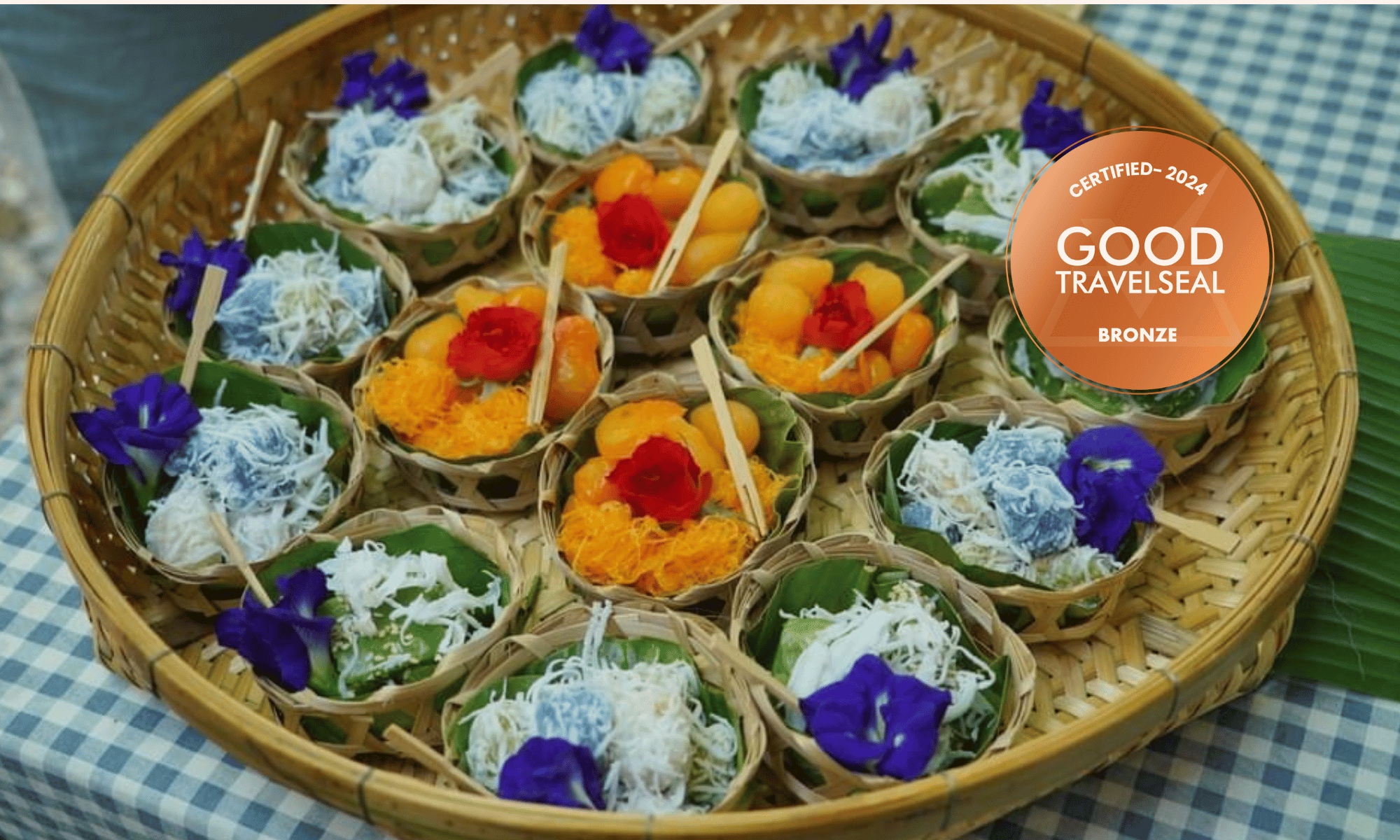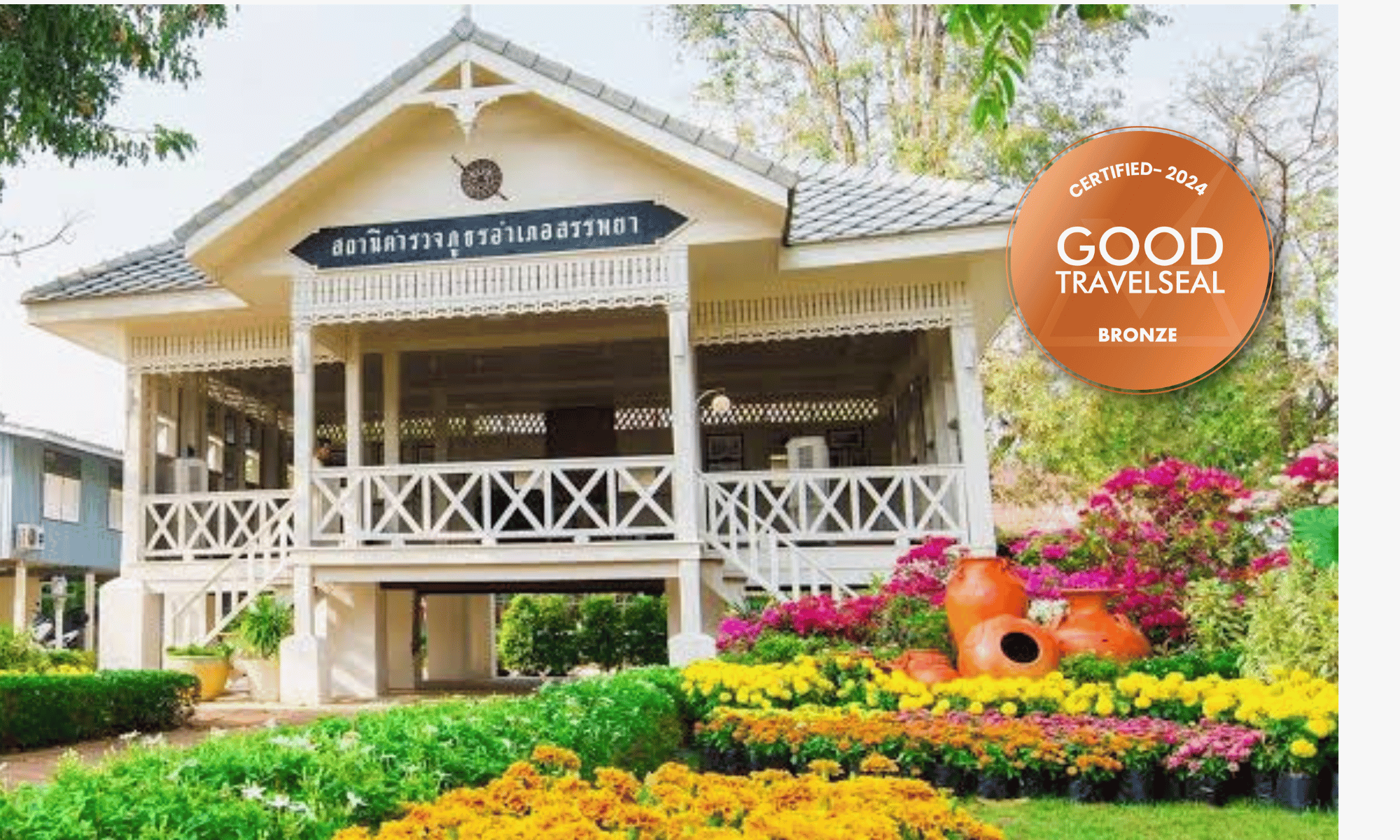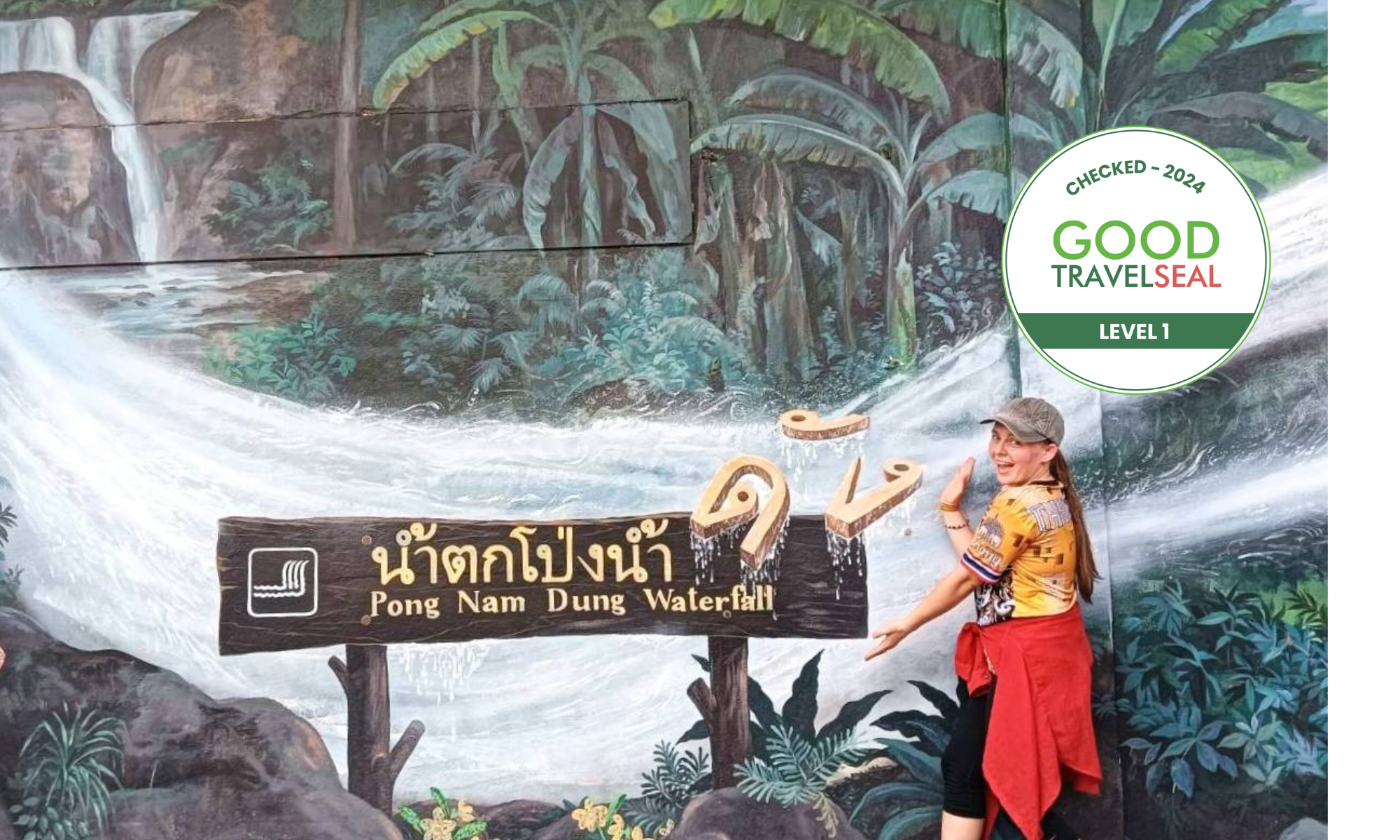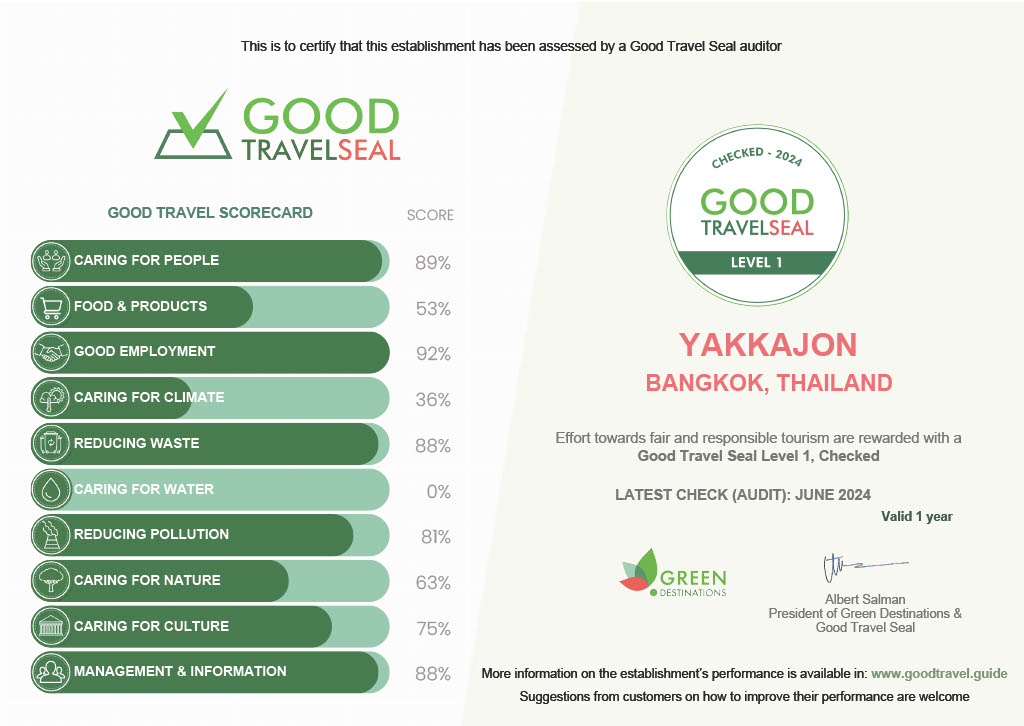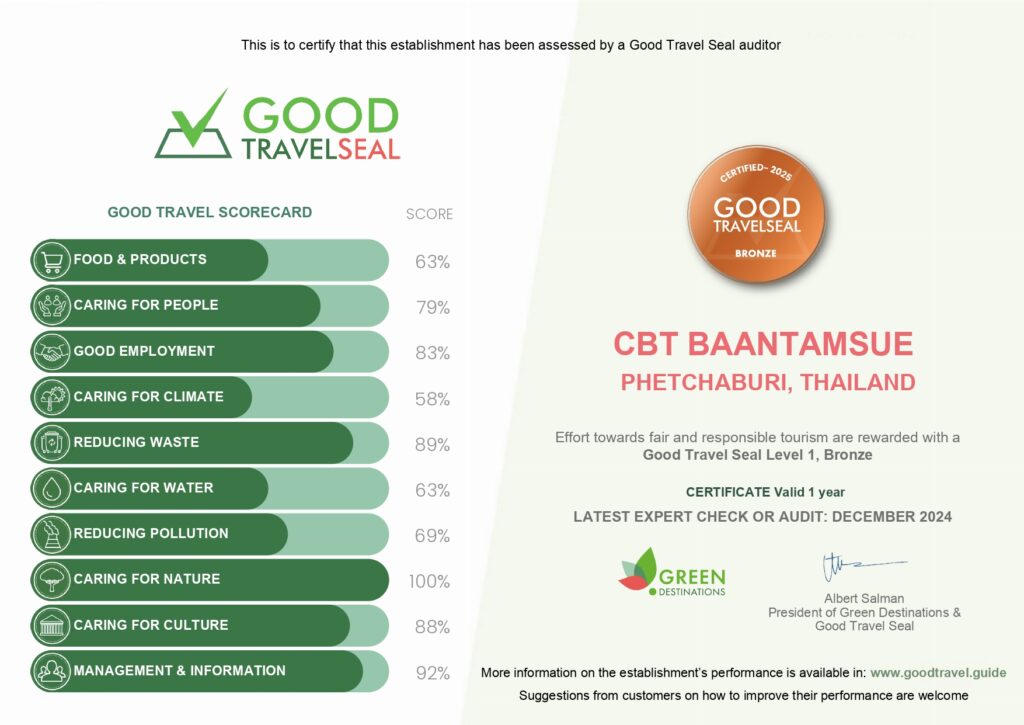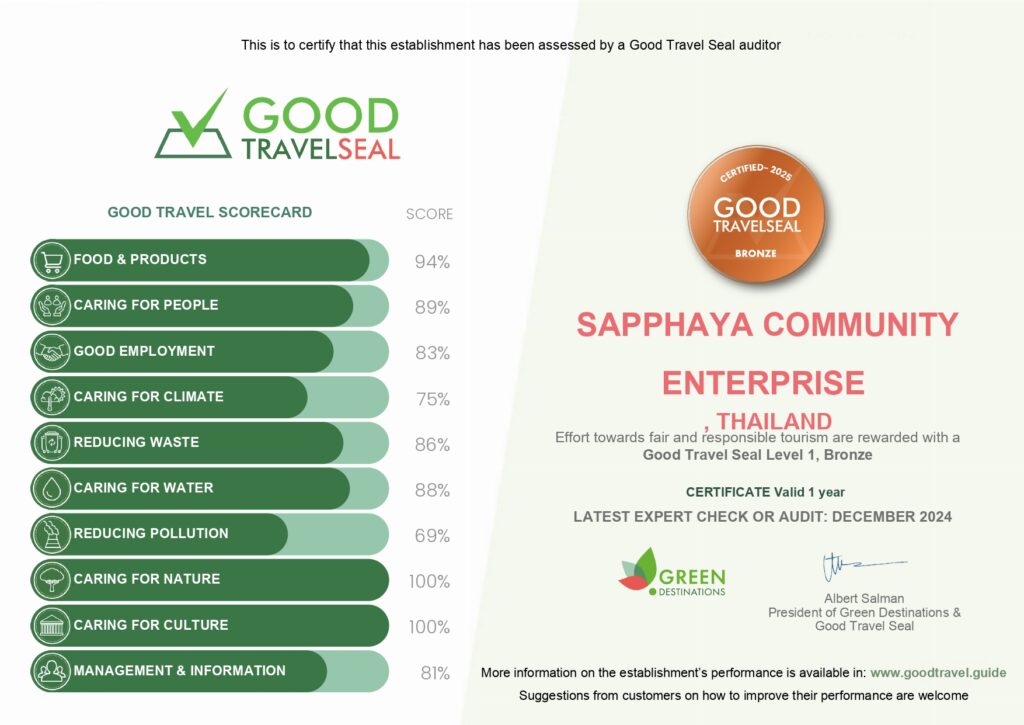Thailand

Travellers love THAILAND for much more than its iconic landmarks and wide open horizons: visitors come for wide range of ecotourism activities: Eco-friendly accommodation in Thailand, wildlife activities. But don’t just stop with the landscapes! Take the opportunity to learn about the people that live in this big country.
Not sure where to go?
Explore the options for a responsible trip
GOOD PLACES TO VISIT
Explore destinations that were recognised for their sustainability efforts
GOOD TRAVEL BUSINESSES
Discover accommodations, restaurants, shops and activities that are committed to sustainability. Their efforts are summarised in a SCORECARD (click on the picture). For the Good Travel Seal, the higher the number of stars or the level (level 3 is the highest), the more aspects of sustainability are checked by an independent auditor.
- Accommodations
- Restaurants
- Activities
Yakkajon
Good Travel Seal Level 1
YakkaJon is Thamturakit registered trademark for restaurants and marts showcasing all the ingredients and recipes of our sufficient food by creative chefs.
PROMO CODE: GD-YKJ
Banthamsuea homestay
Good Travel Seal Level 1
Thamsuea is a community surrounded by mountains, rivers, and Kaeng Krachan forest. Zero carbon travel route Delicious local food and organic farming.
PROMO CODE: TSH2549
Sapphaya's social enterprise
Good Travel Seal Level 1
Sapphaya’s Tourism Social Enterprise in Chai Nat Province is a model for responsible community-based tourism, adopting a “Foam-Free and Single-Use Plastic-Free” concept. Certified and awarded by both national and international organizations, it offers eco-friendly products such as Batik fabrics, Trichawa Tea, and unique souvenirs.
A key attraction is the Green-D Night Market, held on the first Saturday and Sunday of each month, offering a 100% foam-free and single-use plastic-free experience.
The area is also rich in cultural heritage, featuring the Sapphaya Old Police Station, a historic building over a century old, and Wat Sapphaya Watthanaram, which houses a rare Reclining Buddha in the Posture of Paying Homage to the Royal Relics—one of the few in Thailand.
With its commitment to sustainability and cultural preservation, Sapphaya offers visitors a truly unique experience.
PROMO CODE: Contact via gtg to get 10% off.
Maesoonnoi
Good Travel Seal Level 1
It is an agricultural village with nature, waterfalls, forests, water sources and most importantly, “friendliness and community lifestyle” of Ban Mae Soon Noi.
GOOD PRACTICE STORIES

Get inspired with stories from places and people that are acting for a fair and responsible tourism
Chiang Khan
Chiang Khan is an important tourist destination in Thailand, renowned for its historical value, especially the old wooden houses that locals have adapted to accommodate growing tourism. However, although tourists favour staying in these old wooden houses, some have noted that most of these houses do not fully meet their needs, particularly regarding breakfast options. This leads to accommodation operators missing opportunities to meet tourist demands and increase their revenue, affecting Chiang Khan’s economic opportunities, including employment and the income of local service providers. To address this issue, operators of old wooden house accommodations, along with their network partners in Chiang Khan, have sought solutions by leveraging their strengths. They implemented a breakfast coupon system for tourists to use at local restaurants. This approach effectively matches supply with demand, making operators of old wooden houses “intermediaries” between local restaurant operators and tourists seeking breakfast.
Hua Hin
Urban development in Hua Hin has led to challenges in waste management, as garbage overflows threatening the environment and public health of the oldest seaside destination in Thailand. The project “Zero Waste” was born. The journey to achieving this goal was possible through the cooperation of all sectors, from municipality to residents to private organizations. The solution came on different levels , from reducing waste to adopting a circular economy approach. The change made was truly valuable for the environment and the local community.
Songkhla City
Songkhla Old Town faces urban deterioration due to economic, social, and environmental changes over time. Furthermore, a lack of awareness and understanding among the community about the importance of preserving the old city contributes to the destruction of valuable heritage buildings. To counter this trend, the Songkhla Heritage Trust has emerged, uniting individuals dedicated to revitalizing their hometown. Through collaboration with public, private, educational and governmental sectors, the association orchestrates various initiatives. These include soliciting public feedback, showcasing the city’s heritage through visual storytelling, fostering tourism, and creating spaces for youth and community engagement.
U Thong Ancient City
The development and transformation from an abandoned mine, a place to dispose of garbage and use drugs, into a tourism destination. By focusing on the Buddhist teachings and the historical significance of the place, all sectors aimed to transform the area into a tourist destination, enhancing the economic value of Suphan Buri province, creating jobs for local people and creating 95 community-owned shops.
Uthai Thani Old Town
Thailand’s last Raft House community can be found in Uthai Thani Old Town along the Sakae Krang River. It reflects 400-year-old way of life. However, the community has been impacted by drought, resulting in a decrease in water levels and damage to many raft houses with uncertain daily income from fishing, and aquatic agriculture. To preserve this unique community the water quality of the Sakae Krang River needed to be improved, as long as with enhancing the quality of life for residents, and implementing sustainable tourism initiatives that showcase the cultural lifestyle.
Wiang Phu Phiang Chae Haeng
Nestled on a picturesque hill overlooking the Nan River, Wiang Phu Phiang Chae Haeng holds immense cultural significance, drawing devotees from across Thailand. However, tourism in Nan Province faces challenges during the off-season, impacting local businesses. To address this, a unique solution has emerged: revamping the traditional Hok Peng festival with the help of monks, government agencies, tourism businesses, and local communities. This initiative aims to preserve traditions while offering a vibrant cultural experience.
Sustainability
Last year, the Thai government announced more ambitious climate targets and greater priority for the promotion of sustainable practices. Currently, the measures are concentrated in the renewable energy and low-emission transport sectors These efforts, along with growing environmental awareness among both locals and tourists, are contributing to Thailand’s commitment to becoming a more sustainable and environmentally conscious destination.
Travel tips from our editors
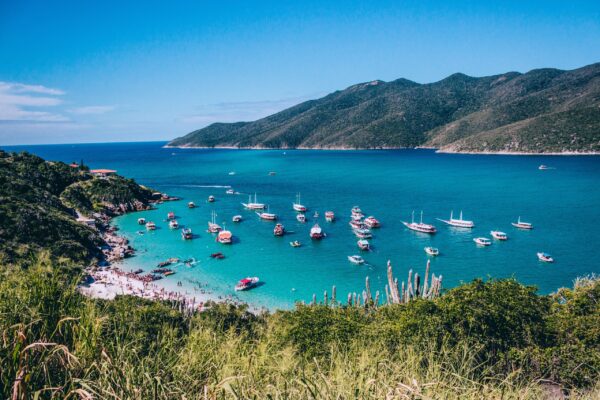
Getting around
Trains are a handy way to travel, particularly between Bangkok and Chiang Mai. Buses are widely available, with both long-distance and local routes. For a more local experience, tuk-tuks and songthaews (shared taxis) are common in many towns and cities. In Bangkok, the Skytrain (BTS) and Metro (MRT) offer convenient and affordable public transportation. Furthermore, its picturesque islands often rely on ferries and boats for transportation between them.
Tourism & People
Tourism in Thailand welcomes millions of international visitors annually and plays a crucial role in the country’s economy, contributing around 13.4% to the GDP in 2019. Popular destinations, such as Bangkok, Phuket, and Chiang Mai, tend to draw large crowds, especially during peak seasons.
While these renowned hotspots might sometimes experience overcrowding, the country offers numerous unspoiled regions, like the mountainous north and peaceful islands, providing travellers with plenty of alternative destinations to explore. Thai locals are known for their warmth and friendliness towards foreign guests, and learning a few basic Thai phrases can enhance your experience, as English is not universally spoken outside major tourist areas.
Nature & Wildlife
Thailand has multiple natural landscapes, ranging from beaches and tropical islands to jungles and mountainous terrains. Its abundant wildlife is a significant draw for nature enthusiasts. The country is home to several national parks and wildlife sanctuaries where visitors can experience the richness of its flora and fauna. Among the wildlife species found in Thailand are elephants, tigers, gibbons, various bird species, and diverse marine life. Additionally, Thailand offers opportunities for activities such as jungle trekking, snorkelling, and scuba diving to explore its captivating natural beauty, both on land and underwater.
Sustainability Recognitions
Brazil has 9 destinations featured in the Top 100 Sustainable Destinations 2021.

Other sustainability certifications can be seen here (English) and here (Portuguese).

Fernanda Rodak | Page Editor
“Brazil is a worldwide known hotspot for biodiversity as well as home to a multitude of cultural expressions. The natural and cultural heritage and immense variety of tourism experiences in the country are valuable assets for its competitiveness. Yet, as we envision a post Covid-19 era, sustainability in tourism becomes crucial to build resilience and guarantee the long-lasting health of Brazil’s ecosystems and well-being of the hosting communities. This would also ensure an active contribution of the country’s tourism sector to the Sustainable Development Goals.”
Visit other destinations nearby?
Get in touch
Support
We are a multicultural, creative and dedicated team working to promote sustainable tourism. Join us in our fight against the climate crisis, single-use plastics and over-tourism!

